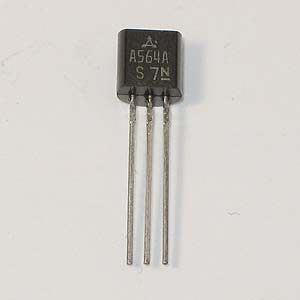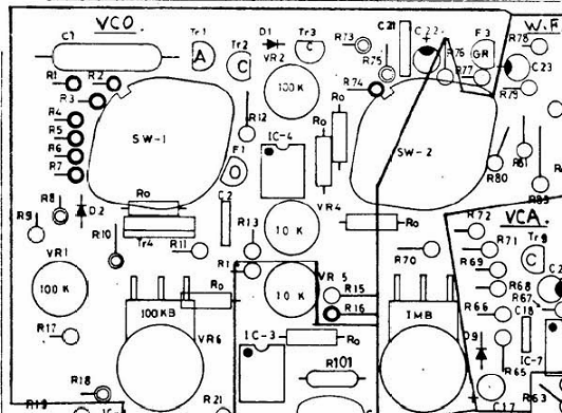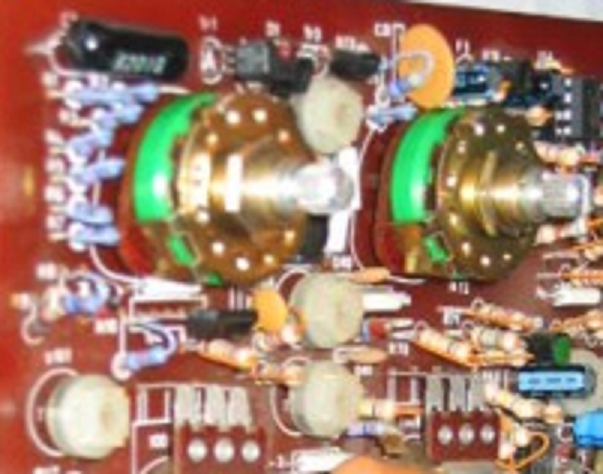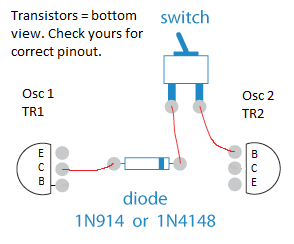The suffix on Japanese transistors seems to refer to specific behavioural ranges, so that you may select a FET with the proper Idss range and regular trannies with specific gain characteristics. Your circuit will function with components which operate in the specified behavioural ranges.
The Oscillator.
2SK30A (GR)
This FET is still easy to find on eBay and other places, and was used in everything from oscillators to effects pedals.
Vgs range: -0.4 to -5.
Idss range: 2.6 to 6.5.
The BF245A covers the same VGS and Idss ranges but goes slightly outside of them as well, so it is a good idea to test and select ones in the desired range(s).
Vgs range: -0.25 to -8.
Idss range: 2.0 to 6.5.
www.smallbearelec.com $1.00 each
2SK30A (O)
Got a batch from Dalbani.co.uk / Nikko Electronics. Good people, I recommend them. Thanks!
Vgs is between -0.4 and -5, same as the GR.
Idss range between 0.6 and 1.4.
Difficult to find! Didn't get a reply from XOX box parts suppliers. The Idss of this component is also evidently directly responsible for the square wave purity/duty cycle of the TB303 oscillator. I haven't seen a specific Idss measurement posted representing the purest square… I note that it appears in the first revision of the MS series noise generator as well.
The 2N4339 of Buchla fame (oscillators, frequency shifter, etc.) is similar. Vgs range: -0.6 and 1.8. Idss range: 0.5 and 1.5. These are very difficult to find, and even then, you'd need one with max Idss. Vgs could also be a little low…I've found some of these online for between $3.53 and $6.70 each.
I note that for some short time, Fairchild produced their own version of these FETs, with a KSK30 prefix. I have not been able to find these components anywhere. If you do, know that
2SK30A GR = KSK30 G (Idss of between 2.6 and 6.50 for both).
2SK30A Y = KSK30 Y (Idss of between 1.20 and 3.0 for both).
2SK30A O = KSK30 O (Idss of between 0.6 and 1.40 for both).
2SK30A R = KSK30 R (Idss of between 0.3 and 0.75 for both).
Check the datasheets to see if pinout is the same.
2SK and KSK are =not= available at Mouser, etc.
TR1 2SA564A (S) or 2SA733 (K)

Image is from goldmine-elec.com.
The 564A is a better component than the 564.
"S" version Hfe: 260-520.
Pinout ECB
www.goldmine-elec.com Item A10402 2SA564A , has "S" suffix. Ten quantity averaged 350 hfe, right in the correct range. They have a mininum $10.00 order, so check out their ICs and such. They have 3046s hidden in the transistor section, for about $0.49 each.
http://www.goldmine-elec-products.com/prodinfo.asp?number=G32158
EAS post that the 733 can be used here per the change to it in the MS50 oscillator. But it's a "K" version, high Hfe, between 300 and 600.
I note that higher gain 733P can easily be in the 400 range as well. I got a bunch of high-gain 733P from Polida on ebay for $2.00.
2SC1685 (S), matched pair(?)
The MS10 Service Manual does not state if these components are special selected / matched. The "S" version of this component has a rated Hfe range of between 290 and 460.
Found some 2SC1685 on eBay and in looking closely at the item photo, noted an "S" on them…they are selling in batches of five; I bought fifty and from that, pulled several pairs matching both Hfe and Vbe, although the Hfes were on the low side of things, averaging around 320. Too bad if Hfe matching isn't important in the oscillator, I'm working on the side of "thorough" because I can.
http://tinyurl.com/42cdyd6
That sale now shows a pic of a "Q" version, not applicable to this build.
2SC1583 (F) or (G).
The difference is in the gain charcteristic(s). F: Between 250 and 500 G: Above 400. Many of these on eBay show an F or G if you enlarge the item photographs, even though the sales listing does not specify "F" or "G".
This component is also used in the original TB303, so you know that the XOX box crowd have them stashed, if you can find anyone willing to part with some. I note that there is a warning in the XOX box crowds against 1583s with a "52G" on them; they may be re-labeled 798s. Check the Hfe to confirm or deny 1583 pinouts…and I see that one seller on eBay does indeed show the 52G, so take care as they may have gotten some from the same source.
andrewselectronics.com lists it for $4.11, but say that they no longer have it, despite their internet posting.
You can match a pair of transistors for this section if you have to, but in my experience, depending upon the circuit, you can end up with much lower performance results than if they are on a single silicon strata as with the 1583.
Two TL081?
I'm not using two TL081 as specified because the MS10 Service Manual shows that there is indeed an 081, IC4 just after the matched resistors, but half of a 4588 is used for the modulation summing, and a 4558 is basically a dual 741. So, a 741 will go there…DIY means each person can choose what they like. I've owned a few MS20s in my day and never found a problem with their tracking or stability so a 741 will be closer to this than other options.
C23
The 10uF electrolytic directly following the main FET might have audible importance, even if its purpose is a slight highpass function (1.4Hz according to EAS..Thanks!). I'm going to try Elna Silmic II caps here because I have some. Sorry, no Mundorfs :D
Worth considering as in this design, the sawtooth waveform is very nearly right out of the FET, only interrupted by the capacitor and a single level-compensating resistor, if that's its function. Nice, clean, gotta have it. No opamps there. The word "discrete" comes to mind, even though the rest of the circuit uses opamps. This part is just fine.
C21
Is a 0.1uf non-polarized; there is only one .1uF listed in the MS10 service manual, a ceramic 25V. It is clearly visible in the following pic.
Mouser, 0.1uf 50V disc, 5mm pitch.
140-50U5-104M-RC
They have small multilayer as well.
6200uF Polystyrene
6800pF Mouser 23PS268 $0.37
(EAS say just play with init Fc trimpot a touch)
or
6220pf polystyrene capacitors, US distributor, $10.00 minimum:
http://www.surplussales.com/Capacitors/Poly-Unelco.html
(CPF) 006220R0AFAV 6220 pF 33v 1% $1.25
C22
10uF / 16V? Listed as such in the 10, 20, and 50 schematics. Shown as the same size as C23 in this MS10 service manual pic, and shows as the same size as C22 in the pic.
MS10 Service Manual, both caps upper right corner:

From:
http://obsoletetechnology.wordpress.com/repairs/korg-ms10/

1S1555 Diodes.
4) 1S1555 (D12 and D13 in the triangle wave circuit appear desirous of matching)
Tubeshunter on eBay have 1S1555 in large batches, but they are actually 1S1588, which are electrically compatable. These are also used in the DS1 distortion pedal.
Diode matching is said to best be accomplished with your VOM at DC voltage, ground to power supply ground, and +15V to a 100K resistor, to the diode to the positive VOM input. I haven't tried this yet.
These do indeed have a different rating than the 4148. Anyhoo, D3 and D4 in the modulation inputs / summing might be worth matching as well, if that sort of thing is very important to you.
Matched pair, 427R
The MS50 oscillator schemo does indeed indicate that these need to be matched. Grabbing 200 quantity 430R 5% as 430R 1% probably won't dip low enough…will select with VOM.
8) 100K point 1% (999,950K to 100,050K only).
Mouser 71-CMF55100K00BHEK
24 for three oscillators is $8.64.
http://tinyurl.com/3n8w8ho
It may be possible to use appropriate value trimpots jumpered across the resistor pads, if you don't have a VOM that can display five or six digits, or if you don't want to order .1% components. In that case, set the trimpots for the appropriate total K for each batch of resistors they are superceding. Turn the hopefully multiturn screw so the VOM jumps between 100,0 and 9999. This is theory, it is untried, so caveat emptor. Of course, you can use your ears against a digital synth for tuning reference.
Linear FM?
The jack at the base of the resistor chain/Scale switch is a hz/volt control voltage input. It would be interesting to use it as an FM input from another oscillator's audio out to see if it makes available some form or amount of linear FM. You could use these oscillators with a MIDI/CV converter capable of producing a hz/volt output.
Possible Oscillator Sync
From:
http://electro-music.com/forum/topic-15824.html
"To hardsync VCO2 to VCO1 all you have to do is connect a diode from the Q4 collector to the Q10 base." (MS20 trannie numbers)

Note that I have not tested this, although I have confirmed that the correct transistor (EAS project nomenclature) on the master oscillator (1) is TR1 (collector) and on the sync'd oscillator, TR2's base.
The EM poster says that it's a bit uneven in locking which might mean that it could use amplification in line between the oscillators...which might also beg the use of a voltage divider to control the overall amplitude of that signal, if it would produce none through soft through hard sync...I have no idea if this would work.
Reference:
http://www.korganalogue.net/korgms/images/service/ms20/circ1.gif
The Filter
Thoughts on the original components within the Korg 35, make sure that your substitutes are in the same behaviour ranges. Here is a link to the beginning of Tim Stinchcombe's amazing MS studies. Wow!
http://www.timstinchcombe.co.uk/synth/korg.html
And to the innards of the Korg 35 itself, thanks again Tim!

From here:
http://www.synthforum.nl/forums/showthread.php?t=127555
2SC1623 L-6.
The L-6 version has a gain range of between 200 and 400 Hfe. It looks like it requires a matched pair, Vbe and Hfe. Or one of those, or neither.
2SA812 M.
Being complementary to the 1623, it has the same gain range.
2SK94 X-2.
Has an Idss range of between 1.0 and 3.0. Vgs is typically -0.5, and overall range is between -0.13 and -1.5. The 2N4339's Vgs range is from -0.6 through -1.8. Its Idss ranges from 0.5 to 1.5. Conceivable to use, but must select for maximum Idss. The BF245A has similar lower range Vgs and Idss, but then goes way above at maximum values so you must select for both characteristics in the ideal range. J201 would have been nice but its Idss maxes at the 94 X-2's minimum, 1.0. In my experience with the J201 you won't find many at all in a batch going above about .90 or even up to / around that.
Link to circuit for measuring Vgs and Idss:
www.forsselltech.com/media/attachments/JFET_Jig1.pdf
The 2SK94 datasheet can be found here, click the Technical Specs link.
http://www.bdent.com/2SK94-p/2sk94.htm
I note that it is extremely easy and very inexpensive to order reels of the 1623 L-6 and 812 M6. Surface-mount, just like in the Korg 35. The difficult thing would be to match the 1623s and the 812 to their gain as well. Difficult to measure surface-mount components… And the 2SK94 X-2 is available in surface-mount, but it appears as a slightly renamed suffix. I have no idea if it is truly a direct replacement with the same characteristics. Suffice to say, the easy availability of these components and their significantly low price for quantities in the hundreds, causes one to consider creating PCBs of dual filters. One per note for a keyboard. Like the legendary PS series.
VCA
The 2SC945K used in the VCA is a generic transistor similar to the American 2N390X series. It is likely the green-dotted transistor in the pic.
The "K" version have a gain or Hfe of between 300 and 600. You'd have to ask Korg how they selected for this particular function, but it would be wise to have your transistor within this gain range. Use a socket if uncertain, and install transistors until you find one exhibiting desirable results, if there is indeed any audible variance. Then again, the MS10 service manual schematic lists it as a "K", whereas the parts list specify it as a 2SC945(L)K. I don't know if this matters as the parts list also reverses the "GR" in the 30A FET. Note that Fairchild had their own version, the KSC945, and it is available at Mouser. The suffix you'd want is "L", with an Hfe range of between 350-700.
Edit, Aug. 5th: Here's hoping that anyone reading this and popping open an MS to get measurements of the VCA trannie will do so and will post the results out of love of the instruments, love of sound, and love of music, and not out of any sort of destructive dominating urge. That only and continues to bring lower the entire field. Okay love you bye bye!
The Envelope
4) 2SC1685(S)
2SA564A(S)
4558 (IC10 is not named in the MS10 service manual but is likely another 4558.)
TL081
4069
4007
10) 1S1555
The MS envelopes are desirable for two main reasons: The Hold function. Specific shape and rates. When I was at Alesis and we wanted two signature "Kraftwerk" snappy samples for the QS line, of quick envelopes hitting self-oscillating filters, we chose two: The Moog Modular as it was very fast and sharp, and the MS20 as it was slower at its minimum settings, producing a slight "wow" and a less-than exponential slope. Both very useful, with the Korg version being even more singular. I do not know if the filter/envelope slope is due to the envelope's shape or from the filter response curve, or some combination of both. It would be interesting to use these modules with other brand modules to make determinations.
1S1555, can use 1S1588, see Oscillator. TR5, 6, 11, and 12 are 2SC1685(S), see above. Found on eBay.
TR8 is listed as 2SA564A(S), and it is assumed that TR7 is as well as three of these are shown in the parts list. These may be a matched pair. If so, it would be a good idea to use 1% or match R42 and R43, 100K, R40 and R41, 47K D6 and D7. See Oscillator, available at goldmine-elec.com for $1.25 each. C35, 6.8uf 16V is tantalum.
MS10 LFO
I don't know why I'd never really taken a look at this classic LFO…one dual opamp, two matched sets of diodes, seven resistors, one capacitor, two potentiometers and an LED…and one unmatched diode in addition but who's counting. A 4K3 resistor is the oddest part. The capacitor is likely the 1uF 100V polyester capacitor listed in the service manual. This is simple enough to breadboard, and the variable saw/tri/saw function is cool enough to build more than one.
The MS50 Oscillator
Of course very similar to the 10 and 20's but has a TEMPCO and puts a couple of extra caps on the IC at the end of the Scale resistor chain. Also, the sawtooth waveform goes through an opamp here, possibly effecting that lovely character.
The MS50 Filter
Uses CA3019 diode array, rare and expensive, or you can match up some super-fast diodes. Also needs a batch of either eight matched or two groups of four matched (don't know if you can just use two groups of four matched) 1S1555 diodes. C16 is a big old 100uF / 3V tantalum in the audio path...? I'd heard that they aren't very good for processing audio... This filter has a nice, cold sine wave, great for making percussion sounds. However, there is a bit of hiss, if memory serves.
The MS50 Sample-and-Hold
Useful if patched with external noise sources and amplifiers because as-is using the internal noise source, you won't get an output hot enough to create a broad modulation range. Nothing odd here excepting the 2SK30A (GR) and 2SC1685 (S).
The MS50 Ring Modulator
Uses the very rare NJM RC4200 IC. IIRC, that IC was also used in a DIY LFO similar to the MS10 in that the waveform could sweep from saw/tri/saw, but was VC. If you can find any 4200s, that would be a better application.
The MS50 ADSR
Fairly simple, IIRC fast enough, only odd bits are four 0.1% 100K resistors, a 6.8uf tantalum cap, and a 1685 (S). Audio pots are used for the time factors. Three outputs of varios scaling and inversion...sweet.
The MS50 Hold/Delay/Attack/Release envelope
Don't remember putting this one to use...again, four matched 0.1% 100K resistors, two 1685 (S), one unnamed trannie (TR6), audio pots for time factors. Very nice to have scaled inversion outputs and a delay trigger output. Very useful if modded for 10V outputs.
The MS50 Audio Amp
Has an envelope follower and Schmidt Trigger output, very nice.